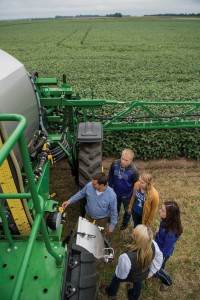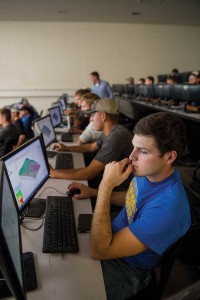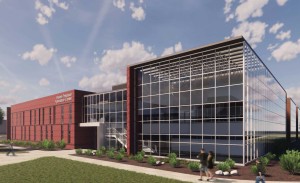The world of agriculture is changing rapidly and SDSU is changing to meet that challenge with its investment in precision agriculture education.
Ground was broken in October for the Raven Precision Agriculture Center, a unique facility that will put SDSU at the forefront of an ever-expanding field.
At SDSU, the first-in-the-nation precision agriculture major brings together campus resources from the departments of Agriculture and Biosystems Engineering and Agronomy, Horticulture and Plant Science and the Jerome J. Lohr College of Engineering. The program’s 71 majors and 68 minors are already learning about cutting-edge developments at the intersection of agronomics, high-speed sensor technology, data management and advanced machinery development.
“What we wanted to do was integrate all of these programs together into a single discipline,†said John Killefer, the South Dakota Corn Utilization Council Endowed Dean of the College of Agriculture, Food and Environmental Sciences. “What we want then is graduates that can utilize these current precision agriculture technologies and be the innovators of future developments.â€
Killefer describes the precision agriculture center in the northwest corner of the campus as being a football field in length in any direction. “It’s not just the size of the building that’s important,†Killefer said, “it’s what’s going to happen inside the building.â€
The dean describes a melding of faculty from diverse disciplines developing a synergy that helps them tackle challenges from various perspectives. The building will also have room for stakeholders to work on their own projects, giving students the opportunity to learn scientific expertise and then see how it is applied to create real-world solutions on the farm.
 Some of those solutions are already apparent to precision agriculture major Cole Berkley from Hot Springs, S.D.
Some of those solutions are already apparent to precision agriculture major Cole Berkley from Hot Springs, S.D.
“The innovations are endless,†Berkley said. “For a very low rate, aerial imagery can improve the bottom line and make pockets for South Dakota farmers and ranchers a lot deeper.â€
Stakeholders in the precision agriculture center project have also been major donors, with South Dakota Corn contributing $6 million.
“This is an amazing opportunity that will position South Dakota as the Silicon Valley of agriculture,†said Ryan Wagner, president of the council.
Fundraising for the $46 million project also benefited from a $5 million contribution from Raven Industries.
“SDSU is leading the way in the development of the next generation of precision agriculture innovators, with an enriching multidisciplinary education and a robust learning experience,†Raven President and CEO Dan Rykhus said.
The need for the state to take the lead in precision agriculture was also recognized at the Capitol where legislators, faced with a tight budget, still managed to find $22 million to invest in the project.
“There are several of us in the legislature who talked about how this is probably the biggest thing we will ever do in our terms,†Rep. Lee Qualm, of Platte, said. “This will go for decades as being one of the most phenomenal things that ever happened to South Dakota, agriculture and for the nation.â€
“SDSU’s precision agriculture initiative has many needs moving forward,†said Mike Barber, the college’s development director. “While we have a large percentage of the private funding secured, we do not have the building fully funded yet, and we are still working with potential donors to garner their consideration. After that, there will be faculty and student support needed too.â€
Those investments will go a long way toward helping students like agronomy and precision agriculture double major and third-generation farmer Johnna Jorgensen from Mount Vernon, S.D., go back to the home place.
“Farming is a tradition, and it’s all about where your roots are from,†Jorgensen said. “I foresee it being in my family for a very long time.â€
 – Dana Hess







